Rugby’s tough, muddy, and loud—but playing under bad lights? That’s just confusing. Whether you’re a local club or a big stadium, good lighting means the difference between a winning try and a stray pass to the ref. So grab your clipboard and let’s shine some (LED) light on how to plan, buy, install, and fund your perfect rugby field lighting—no jargon, just bright ideas.
Reach out for free lighting consultation
Table of Contents
Toggle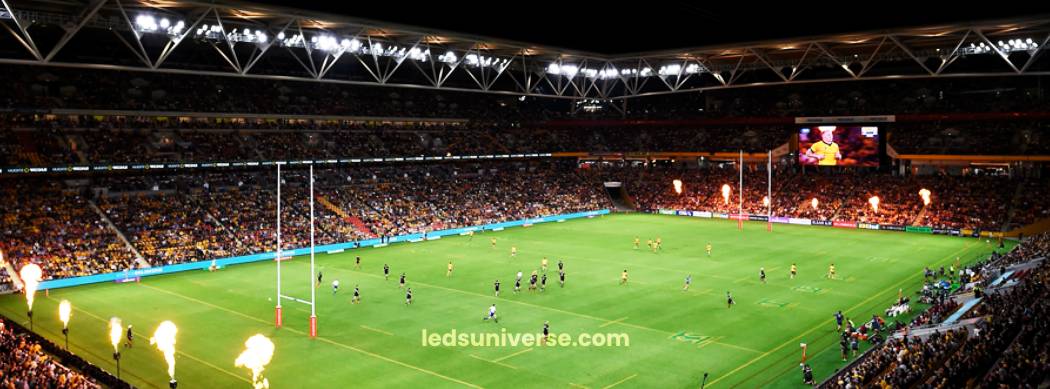
The cost of rugby stadium lighting varies substantially depending on the purpose of the field and the standards it is expected to meet. Training grounds generally have the lowest lighting requirements, typically ranging from 100 to 200 lux. At this level, the lighting system mainly serves to ensure player safety and adequate visibility during evening practice sessions. LED floodlight systems designed for basic training fields usually fall in the range of $25,000 to $70,000, depending on the size of the field, the number of poles, and the quality of fixtures selected.
For community and amateur-level matches, lux requirements increase to around 300 to 500 lux to ensure consistent illumination across the playing surface. The lighting for these fields must not only support better visual performance for players but also accommodate small groups of spectators. Systems built for this purpose often range between $80,000 and $150,000. These systems typically include mid-tier LED fixtures that offer better optical control and longer lifespan compared to basic models.
Professional rugby stadiums, particularly those that host national or international matches or are used for televised events, are in an entirely different category. Illumination levels in these cases often range from 800 to 1500 lux, depending on the broadcast requirements, with higher levels required for ultra-high-definition (UHD) coverage. For stadiums at this level, the cost of the lighting system can easily exceed $300,000. In some cases, particularly when high-end lighting controls and broadcast-grade LEDs are used, the price can approach $600,000 or more.
| Competitive Level | Lux Requirement | Estimated Lighting System Cost (LED) | Typical Use Case |
|---|---|---|---|
| Training Fields | 100–200 lux | $25,000 – $70,000 | Basic practice sessions, limited use after sunset |
| Community / Amateur Matches | 300–500 lux | $80,000 – $150,000 | Local games with spectators, multi-use fields |
| Professional Matches | 800–1500 lux | $300,000 – $600,000+ | National/international play, televised events |
LED technology has become the preferred solution for nearly all modern rugby field lighting projects. While the initial cost of LED fixtures is higher than traditional metal halide systems, the long-term benefits in efficiency and durability are significant. A high-performance LED fixture can last up to 100,000 hours under controlled usage, whereas metal halide lamps usually offer lifespans in the range of 10,000 to 20,000 hours. This difference translates into reduced maintenance, fewer replacements, and less downtime for repairs.
Energy efficiency is another key advantage of LED over metal halide. LED fixtures produce more lumens per watt, which means they can achieve higher lux levels while consuming significantly less electricity. Metal halide systems also tend to lose brightness over time, a phenomenon known as lumen depreciation, which leads to inconsistent lighting and the need for more frequent relamping. LEDs maintain consistent output throughout most of their service life, ensuring uniform light levels and better visibility.
However, for facilities operating on a tight upfront budget, metal halide may still appear attractive due to their lower purchase cost. A complete metal halide lighting system for a mid-level rugby field may cost 20 to 30 percent less than an equivalent LED system at the time of purchase. But when factoring in the increased maintenance, shorter lifespan, and much higher energy consumption, the long-term operational cost of metal halide systems often outweighs the initial savings.
| Lighting Type | Initial Cost | Lifespan | Energy Efficiency | Maintenance Needs | Total Cost Over Time |
|---|---|---|---|---|---|
| LED | Higher (by 20–30%) | 50,000–100,000 hours | High (more lumens/watt) | Low (less frequent relamping) | Lower (better long-term ROI) |
| Metal Halide | Lower upfront | 10,000–20,000 hours | Lower (more energy use) | High (frequent relamping) | Higher (due to maintenance & energy costs) |
When analyzing the full lighting package, it’s helpful to understand how much of the total budget is allocated to the fixtures themselves. In most rugby field lighting projects, the cost of the floodlights accounts for approximately 60 to 70 percent of the entire lighting system. This figure includes not just the fixtures but also associated lenses, drivers, and heat dissipation systems integrated into the light heads.
The remaining 30 to 40 percent of the budget generally goes toward infrastructure components such as lighting poles or mast arms, foundation work, electrical panels, and cabling. Advanced lighting systems may also include digital control units that allow for scheduling, dimming, and zoning, which can help reduce operating costs and improve flexibility for different event types.
Purchasing a lighting package as a bundled system from a single supplier often provides better integration and support compared to sourcing components separately. Some manufacturers also include design services, lighting simulations, and compliance documentation within their product offering, which adds further value to the overall investment.
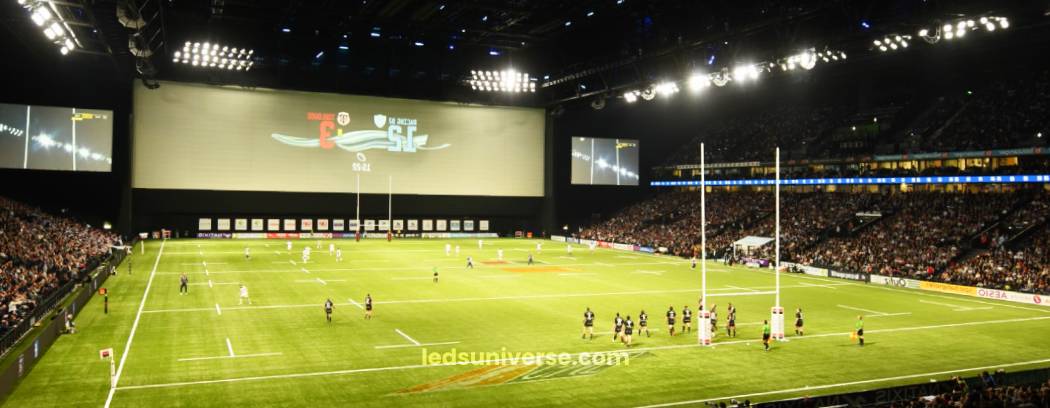
When planning lighting for rugby fields that will host professional competitions or televised games, there are specific technical standards that must be met. Broadcast-quality lighting requires not just high lux levels but also excellent uniformity, minimal glare, and extremely low flicker. These factors are necessary to ensure that fast-moving play can be captured clearly on high-definition or ultra-high-definition cameras without shadows or visual artifacts.
High-end LED floodlights designed for broadcast use often feature precise beam control, anti-glare visors, and flicker-free drivers that support frame rates up to 1,000 frames per second. These fixtures are significantly more expensive than standard LED lights. A single broadcast-grade fixture can cost between $3,000 and $6,000, and a full stadium may require 40 to 80 of them, depending on the lighting design and pole configuration.
In addition to the cost of the fixtures themselves, broadcast-grade lighting systems usually require more poles or more powerful mounting brackets to achieve the necessary aiming angles and eliminate dark zones. This adds to the overall cost, but for professional venues, these elements are non-negotiable due to compliance with broadcast standards from organizations such as World Rugby or national sports networks.
While the upfront purchase cost of rugby stadium lighting can be daunting, it’s crucial to evaluate the total lifecycle cost of the system. Cheaper systems may save money in the short term but incur much higher operating and maintenance costs over the years. High-quality LED systems, although more expensive to install, often provide a better return on investment due to their energy efficiency, reliability, and reduced maintenance needs.
Working with experienced lighting designers and reputable manufacturers helps ensure that the system will meet performance goals without unnecessary overspending. Detailed photometric analysis, site surveys, and budget forecasting are valuable steps in getting an accurate cost estimate tailored to each rugby field’s specific needs.
Ultimately, the true cost of rugby stadium lights is about more than just fixtures. It reflects the desired performance, quality of play, safety standards, and longevity of the system, all of which contribute to the overall success of the facility.
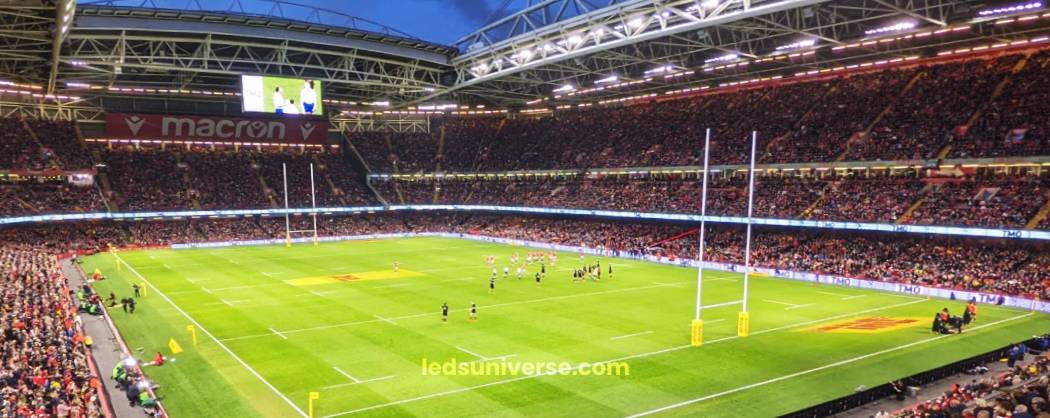
Once the lighting system is installed, the ongoing operating cost becomes a central factor in budget planning—particularly for schools, community clubs, and local councils that must balance performance standards with limited resources. The dominant expense over time is electricity usage, which is directly tied to the wattage of the system, duration of use, and frequency of events.
In most cases, maintenance costs remain modest when using modern LED systems, but the electricity bill is consistent and accumulates quickly if not carefully managed. For this reason, understanding typical energy consumption figures helps facility managers and club operators anticipate monthly and yearly financial commitments.
To provide a practical illustration, consider a standard-sized rugby field equipped with lighting suitable for amateur-level competitions, typically requiring an illumination level of 500 lux. Suppose the lighting system utilizes 1500-watt LED floodlights, and a total of 16 fixtures are installed to meet uniformity and brightness standards. The combined electrical load in this scenario is 24,000 watts, or 24 kilowatts (kW).
Now, if this field hosts five evening events per week, with each event lasting about three hours, the monthly energy consumption becomes significant. The calculation would be:
24 kW × 3 hours × 5 sessions per week × 4.3 weeks ≈ 1,548 kilowatt-hours (kWh) per month
Assuming the average electricity rate is $0.15 per kWh, the monthly electricity cost would be approximately:
1,548 kWh × $0.15 = $232.20
Over the course of a full year, this results in a total operating electricity cost of roughly $2,786. For many small or mid-level clubs, this represents a manageable but notable ongoing expense, particularly when paired with other field or facility costs.
The energy requirements rise considerably when the lighting system is upgraded to meet higher competition standards, such as those for televised or professional-level matches. Fields that require 800 to 1500 lux, for instance, may need to install more powerful fixtures or increase the total number of lights. In such cases, the total wattage can climb to 50 kW or more, potentially doubling or even tripling the electricity bill.
Despite the efficiency gains of LED systems compared to traditional technologies like metal halide, the sheer brightness required for professional applications pushes energy usage significantly higher. Without the use of smart controls, scheduling systems, or dimming features, these higher-end systems can become disproportionately expensive to operate—particularly if they are used regularly throughout the week.
While energy usage forms the bulk of operational expenses, maintenance costs should not be overlooked. One of the major advantages of using LED lighting systems for rugby fields is their extended service life. Most high-quality LED fixtures are rated for 50,000 to 100,000 operating hours, meaning they can last many years with minimal intervention.
This long lifespan translates into fewer lamp replacements, reduced need for service crews, and less frequent disruptions to field availability. Over time, these savings add up and contribute significantly to the overall cost-effectiveness of the system.
That said, some level of upkeep is still necessary. Even LED lights may occasionally suffer from driver failures, lens discoloration, or debris accumulation on the fixture housing, especially in outdoor environments exposed to dust, wind, and weather. For a typical rugby field, routine inspections and light cleaning may only cost a few hundred dollars per year. However, if parts need replacing—such as damaged control gear or failed LEDs—the cost can rise to a few thousand dollars annually, depending on how often the lights are used and the quality of the installation.
One of the best strategies to manage long-term operating costs is to invest in a well-designed lighting system from the outset. Proper beam angles, light placement, and targeted lux levels can reduce the number of fixtures needed without sacrificing visual performance. Additionally, lighting control systems—such as programmable timers, motion sensors, or dimming protocols—can help facility managers optimize usage patterns and prevent lights from running longer than necessary.
By implementing controls that match operational demand, it’s possible to extend the lifespan of fixtures while reducing energy costs, especially for facilities that operate seasonally or only host occasional events. These systems also offer the flexibility to switch between modes, such as full illumination for matches and partial lighting for training or maintenance, ensuring that electricity is used efficiently at all times.
| Installation Component | Cost Range | Key Influencing Factors |
|---|---|---|
| Total Installation (Typical) | $30,000 – $100,000 | Field size, terrain, number of poles, accessibility, labor rates |
| Pole Foundations | $15,000 – $30,000 | Pole height (especially >15m), soil stability, reinforcement needs |
| Electrical Work | Varies widely | Trenching, conduits, switchboards, smart controls, power supply integration |
| Roof-Mounted Systems | +$10,000s (extra cost) | Structural reinforcement, seismic/wind code compliance, rigging equipment |
| Terrain & Site Preparation | Variable | Ground leveling, soil type, drainage, cabling trenching complexity |
| Labor & Equipment Rentals | Major portion of budget | Local labor costs, union requirements, crane/lift rentals for pole or rooftop access |
The installation cost of a rugby field lighting system often equals—or even surpasses—the cost of the lights themselves. While the price of fixtures can be estimated with relative accuracy based on lighting standards, installation costs are highly variable and largely shaped by site-specific factors such as terrain, soil composition, existing infrastructure, and the accessibility of the construction area.
Even before the first light goes up, careful planning is required to address ground leveling, trenching for electrical cabling, and compliance with structural and electrical codes. In challenging environments—such as fields built on rocky ground or near flood-prone zones—additional measures like soil stabilization or drainage management may be required, driving the cost upward.
For a typical full-size rugby pitch, installation costs generally range from $30,000 to $100,000. On the lower end of the spectrum are training fields or smaller community grounds that use 4 to 6 light poles, have minimal trenching, and are located on flat, accessible land. These projects may require only basic electrical work and limited manual labor, keeping overall costs down.
At the higher end are match-grade fields, especially those with higher illumination levels, which require taller poles, longer cable runs, and heavier-duty electrical infrastructure. When a field is built on uneven terrain or has difficult access for construction equipment, the complexity and cost of the installation can increase dramatically. Likewise, local labor rates, availability of licensed electrical contractors, and any need for after-hours work to avoid disrupting existing field use can all influence the final price tag.
Among all installation tasks, the construction of pole foundations is often one of the most expensive. Light poles—particularly those over 15 meters (50 feet) tall—must withstand wind loads, vibration, and lateral movement over time. This requires deep, reinforced concrete foundations that can cost several thousand dollars each. In soft or unstable soils, the depth and diameter of the foundation may need to be increased, or additional reinforcement methods like soil compaction or pilings may be necessary.
For fields using six or eight poles, the foundation costs alone can account for $15,000 to $30,000 of the total installation budget. While the technology behind the fixtures might draw more attention, these structural components are absolutely essential to long-term safety and stability.
In stadiums or rugby fields with permanent grandstands, lighting may be mounted directly to rooftops or canopies, particularly in urban settings where space for poles is limited. This approach avoids the need for pole foundations but brings in a different set of structural challenges. Roof-mounted lighting requires that the building support both the static load of the fixtures and the dynamic wind loads acting on them.
In many cases, this means the stadium must undergo structural reinforcement, often involving steel bracing, custom rigging, or welded mountings. The added engineering and labor required for this type of work can easily add tens of thousands of dollars to the lighting installation cost. It also typically involves structural engineers, specialized rigging teams, and compliance with seismic or wind-resistance standards, depending on the region.
Another key portion of installation expenses comes from electrical work, which includes everything from trenching and conduit installation to control panel setup and integration with the existing power supply. Even simple fields require underground conduit for cabling, weatherproof switchboards, and junction boxes for proper power distribution.
For fields designed with advanced control systems, such as programmable lighting zones, dimming capabilities, or automated scheduling, additional components like smart controllers and sensors need to be installed and calibrated. This not only raises the cost of the equipment but also increases labor complexity, particularly if electricians need to coordinate with control software vendors or network specialists.
Labor, as always, is one of the largest cost drivers. Depending on the region, the cost for licensed electricians and skilled laborers can vary widely. In some urban areas, prevailing wage laws or union requirements may significantly raise installation costs. Additionally, if specialized lifting equipment or cranes are needed to mount fixtures onto tall poles or roofs, rental and operator fees can further inflate the final bill.
The total cost of lighting a rugby field is shaped by far more than just the choice of fixtures. From field dimensions and pole height to lux levels and environmental challenges, a range of factors can significantly affect both the initial investment and long-term operating expenses. Understanding these elements is essential for accurately planning a rugby field lighting project.
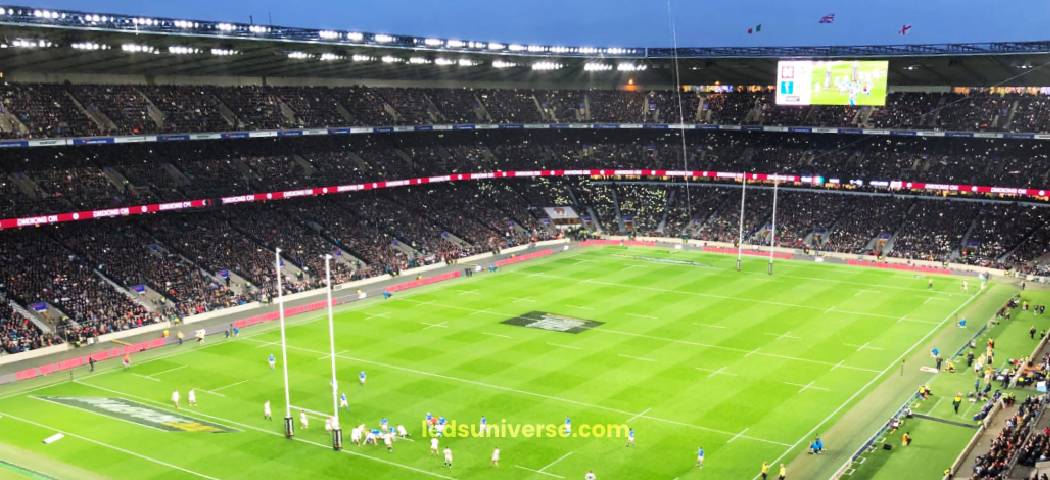
While the standard dimensions of a rugby field are 100 meters long by 70 meters wide, many fields deviate from this template. Youth leagues, mixed-use sports facilities, or international training grounds often include larger safety zones, extended sidelines, or adjacent practice spaces. These additions require a broader light spread and more fixtures to ensure even coverage.
Fields with increased surface area may need to shift from a four-pole system to a six- or eight-pole design. This adjustment not only increases the number of lights but also affects pole foundations, electrical loads, and overall infrastructure, leading to higher capital costs and more complex installation logistics.
The mounting height of the lighting system is one of the most important design parameters in achieving consistent illumination across the field. Taller poles allow for wider beam coverage, which helps minimize shadows and glare—key concerns in both competitive play and televised environments.
However, there’s a price to be paid for height. A 15-meter pole might cost around $2,500, while a 30-meter version can exceed $7,000, and this is before installation is considered. Taller poles require larger concrete foundations, more substantial mounting hardware, and heavy equipment such as cranes to install. These factors can drive up labor costs and extend the installation timeline, particularly in regions with strict safety or wind-load regulations.
The required lux level, or the amount of light delivered to each square meter of field surface, is one of the most influential cost drivers in any rugby lighting project. Training fields may operate adequately at 100 to 200 lux, but club matches typically require 300 to 500 lux. For professional matches or televised events, designers must reach 800 to 1500 lux to meet visual and broadcast standards.
The jump in lux requirements demands more powerful LED fixtures, often with higher wattage and precision optics. It also means more fixtures overall, which increases the load on the electrical infrastructure and adds to the operational cost. For example, a lighting system designed to deliver 1200 lux may need twice the luminous output of one targeting 500 lux, impacting fixture count, energy draw, and system complexity.
Designers must weigh these needs carefully, as overshooting the lux requirement can result in unnecessary expenditure, while underlighting can compromise safety, playability, and regulatory compliance.
The choice of LED fixture plays a critical role in the balance between performance, compliance, and cost. Entry-level LEDs may be sufficient for school or recreational fields, but professional-grade stadiums often demand fixtures with flicker-free drivers, advanced cooling systems, and tight beam control to meet the rigorous standards of EN 12193 or World Rugby broadcast requirements.
High-performance fixtures designed for broadcast use feature anti-glare visors, asymmetric beam angles, and extremely high color rendering indexes (CRI). These components enhance clarity for both players and spectators, especially under ultra-HD cameras. However, such fixtures can cost several times more than basic models, especially when bundled with smart control systems or compliance software.
The physical location of the rugby field also affects lighting costs in significant ways. In remote or rural areas, transportation fees for poles, fixtures, and equipment may be higher. Skilled labor may be scarce or more expensive, and delays due to weather or site access can further escalate costs.
Site-specific challenges such as rocky terrain, sloped ground, or unstable soil often require customized foundation work and special excavation techniques. In such cases, pole bases must be engineered for extra depth or reinforced with steel, increasing both material and labor costs.
Conversely, urban locations, while closer to infrastructure and labor, come with their own set of challenges. Limited space for cranes, permit restrictions, and strict light spill regulations may require the use of directional shielding, low-glare optics, or tighter beam aiming strategies. These adjustments typically mean higher design complexity and added equipment costs.
Installing lighting on a rugby field is a significant investment, but it doesn’t have to become a long-term financial burden. With the right design strategies and smart technology choices, it’s possible to cut costs while still delivering high-performance, compliant illumination. Savings can be realized both during the initial installation and throughout the system’s operational life.
One of the most effective strategies to reduce both upfront and ongoing costs is choosing LED lighting systems with dimmable controls. These allow operators to tailor the light output to match the type of event—reducing intensity for training sessions or warmups and using full power only for competitive or televised matches.
By avoiding unnecessary full-power operation, facilities can cut energy usage by 30% or more, which directly translates into lower monthly electricity bills. Dimming also extends the life expectancy of the fixtures, delaying replacement costs and reducing maintenance frequency.
Not all LED fixtures are created equal. While high-efficiency models might carry a higher price tag, they deliver more lumens per watt, meaning they produce greater brightness using less power. Over time, this efficiency results in substantial savings on energy bills, especially in fields that host frequent events.
Choosing fixtures with superior optical performance also means fewer lights may be needed to meet target lux levels, which can reduce the total number of poles, cables, and installation work. That upfront investment in premium components often pays for itself within just a few years of regular operation.
Upgrading to a smart lighting system with remote management capabilities can generate both immediate and long-term savings. These systems allow for scheduling lights to turn on and off automatically, helping prevent energy waste from human error or overlapping usage times.
Smart systems also offer real-time usage monitoring, delivering insights into how the field is used throughout the week. Facility managers can use this data to adjust scheduling or light zoning, prioritize upgrades, and plan maintenance more effectively. In some cases, automated systems can even integrate with weather conditions, further optimizing power consumption.
When budgets are tight, a modular installation strategy can make rugby field lighting more affordable. Instead of building out a full 500- or 1000-lux system at once, facilities can begin with a configuration suitable for 200 lux training-level lighting and upgrade over time.
This phased approach spreads out costs over multiple seasons or fiscal years, allowing clubs or schools to avoid large capital expenditures while still making tangible improvements. As usage demand grows or funding becomes available, additional fixtures, taller poles, or higher-output lamps can be added without needing to redesign the entire system.
Environmental resilience is another area where long-term savings can be achieved. In regions prone to high winds, heavy rain, or temperature extremes, using rugged poles and mounting hardware can prevent frequent repairs or catastrophic failures. The additional cost of wind-rated structures or reinforced foundations is often far less than the cost of repeated replacements or storm-related damage.
Similarly, LED floodlights with a high ingress protection rating (IP66 or higher) are better equipped to handle rain, dust, and snow. These fixtures tend to last longer in outdoor sports environments, especially where cleaning and maintenance may be infrequent. Spending slightly more for weather-resistant fixtures helps avoid early breakdowns, keeping maintenance budgets under control over the system’s lifespan.
Bringing a rugby field lighting system from concept to completion often hinges on securing the necessary financial support. While the technology and infrastructure are readily available, the initial capital outlay can be a major obstacle, particularly for amateur clubs, schools, and community-based organizations. The good news is that a range of funding strategies and assistance programs can help make these projects feasible.
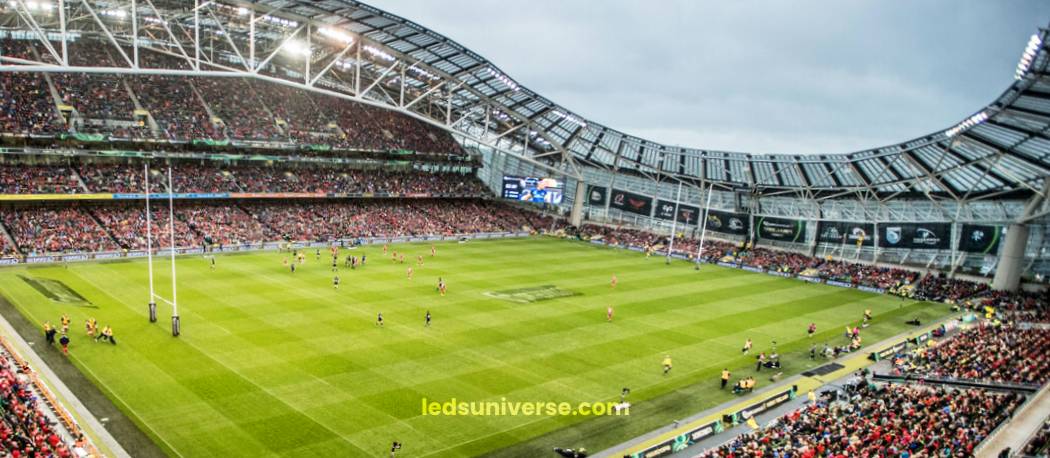
One of the first avenues to explore is financial assistance from national and regional sporting bodies. Many countries have sports councils or rugby federations that actively support infrastructure development, especially at the grassroots level. World Rugby and national rugby unions often run programs aimed at growing the game, which include funding support for facilities, lighting upgrades, and accessibility improvements.
These grants may cover a portion of the installation cost or provide equipment at a reduced price through strategic partnerships. Clubs applying for such funding are often expected to demonstrate community impact, development goals, and long-term sustainability, so it’s essential to prepare a compelling proposal with usage plans and future expansion potential.
In addition to sports-specific grants, many rugby clubs—particularly those affiliated with schools or educational institutions—can tap into government-funded infrastructure programs. These might include state or regional development funds, school facility improvement schemes, or recreational grants aimed at increasing public access to physical activity.
Such programs often prioritize projects that promote youth involvement, inclusion, and community wellbeing. A rugby field lighting upgrade that enables after-hours use, safer playing conditions, or expanded programming may qualify under several categories, from health and education to regional development.
For many clubs, especially those rooted in the community, securing sponsorship from local businesses is a viable and mutually beneficial approach. Small and mid-sized companies often welcome opportunities to increase visibility and support local initiatives, especially if they align with family-friendly, health-oriented, or educational missions.
In return for their support, sponsors may receive advertising rights on signage, mentions during matches and events, or even naming rights for the field or lighting system. Some larger corporations engaged in corporate social responsibility efforts also provide funding or in-kind support for community sports infrastructure.
In recent years, crowdfunding has become an increasingly popular tool for sports clubs looking to fund upgrades without relying solely on institutional support. By rallying fans, families, and local residents, clubs can build a sense of ownership and momentum around the project. Platforms designed for community causes make it easy to collect and track donations, while campaigns that include videos, testimonials, and clear goals often perform best.
Linking the lighting project to broader community benefits—such as expanded youth programming, evening training sessions, or inclusive recreation—can strengthen the appeal and encourage higher participation rates. The added bonus of community engagement often extends beyond the financial goal, creating lasting relationships that benefit the club long term.
For larger venues or clubs with stable revenue streams, financing options such as low-interest loans or equipment leasing may offer the flexibility needed to proceed without waiting for full capital funding. Some LED lighting providers and energy efficiency firms now offer pay-as-you-save models, where the system is installed upfront and repaid over time through the monthly energy savings it generates.
This approach not only reduces the need for significant upfront investment, but also aligns the financial outlay with actual performance. In effect, the lighting system pays for itself gradually as energy costs drop. For clubs that host regular events, rent out their facilities, or maintain a strong membership base, this model provides a sustainable and scalable way to upgrade lighting without overextending budgets.
Rugby field lighting is a major investment that can dramatically enhance the playability, safety, and professionalism of a venue. While the costs can vary based on numerous factors, from field size to lux requirements, thoughtful planning and efficient technology can make the project both feasible and sustainable. With the right funding strategy and smart design, clubs at all levels can achieve lighting solutions that meet their needs well into the future.